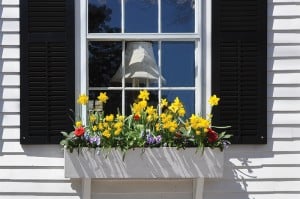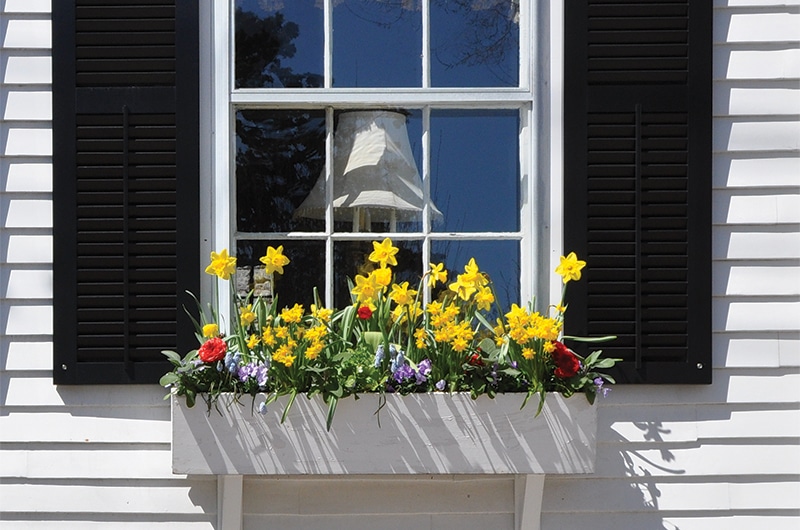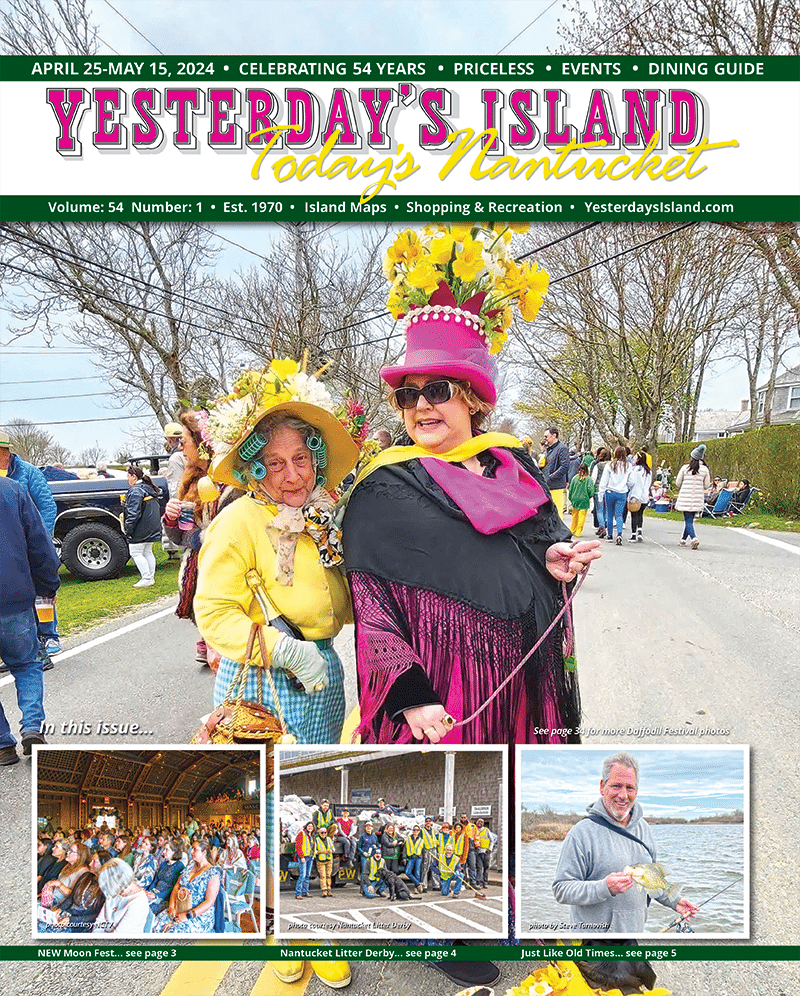• by Hilary Newell – Hilary Newell came around the point 28 years ago and has been learning island-style gardening ever since. •

But maybe you don’t know how to start the whole project. So here are some things to think about before getting started.
Exposure.
Take a look at the area where you want to hang your window box. Which wall of the house is it on? If it is on the South side, and there are no large trees shading that wall, you need to choose plants that are labeled for ‘Full Sun’ only. The sun on the south side is fierce, and plants that need some shade probably won’t make it. Conversely, boxes hanging on the North end of your house need to be planted with plants labeled for ‘Shade.’ East walls and West walls are able to accommodate plants with a broader tolerance for differing light levels. Know how much sun or shade your window box is going to get.
Care.
How much time will you have to care for your window boxes? Having beautiful flower boxes is not a ‘set it and forget it’ proposition. You have to expect to spend a little time each week caring for your plants, but you can mitigate this by choosing low care varieties. Supertunias and many other new cultivars of annuals are bred for thriving in low care situations. Water and fertilizer are needed, but
pinching, dead-heading and trimming are not. Some daisy-type flowers do very well in full sun, but they require constant pruning and heavy feeding to continue blooming. If you don’t have the time to dedicate to that, stay away from Marguerite Daisies. If you don’t want to spend any time on maintaining window boxes, don’t plant them. Or hire someone to take care of them for you. But don’t plant plastic flowers. Please.
The box.
There are directions all over on-line on how to construct your own window boxes. If you have a handy person around your house that can do that sort of thing, lucky you. If you are like me, that other person around the house is way better at working in the garden and cooking than working with wood-shop tools, and frankly, I prefer that he keep all his limbs, so I would choose to purchase window boxes that are all ready for me to plant in. They come in all kinds of styles with fancy internal watering systems, warrantees against rot, new technology, liners, no liners, and what not, but the most important thing that a window box has drainage. Or ‘weep holes’ as one site described them. Save your weeping for when the box falls off the house, just be sure the box has really good drainage holes. Most pre-made or custom-made boxes will have drainage holes, but if you acquire some without, you can drill holes easily, without danger to life and limb. I picked up a new trick last year when I saw someone planting a container where the drainage holes were too big and she placed a kitchen sponge over the hole to keep the soil from draining out of the hole. The drainage holes can be up to about a half inch is fine. Soil won’t wash out, but excess water will drain.
Soil.
And speaking of soil…that’s what it is. It’s soil, not dirt. Soil is a living environment complete with good bacteria and microorganisms that plants need to thrive. It contains decaying organic matter, micronutrients, beneficial fungus and other living organisms, minerals, air, and decaying bodies of tiny insects. Dirt is what lives in the bag of your vacuum cleaner. Because the plants in your window box are contained, and not connected to the earth, the soil they are planted in needs to be as alive as possible. Choose a potting mix that is labeled for containers and your plants will be happy.
Fertilizer.
The new Town of Nantucket fertilizer application regulations do not address container plantings, but we should all keep them in mind. Containers do need to be fertilized to keep blooming all summer, so avoid letting too much excess water run out of your pots when you do fertilize. Incorporate Plant Tone (or your favorite granular organic fertilizer) into your container soil at the time of planting, and start a liquid feed program of Neptune’s Harvest Seaweed and Fish emulsion in early July. Keep applying every two weeks, always following the package directions.
Compatibility.
You can’t go onto match.com to figure out whether your plants will be compatible with each other, but a little investigation will go a long way to ensuring the success of all the plants in your boxes. Check the tags for things like ‘keep moist’ and ‘let dry well between waterings.’ And be sure to pick plants with he light requirements that will meet the light level at your home. Geraniums need a lot more light than ferns or Lobelia, so if you plant them together, chances are that only one will thrive – the one whose care tag matches the light level where they are planted. Plants that need to dry out like Portulaca will not perform well when planted with something that requires a lot of water. One will drown or the other will wilt.
Color.
Do you like wild colors? Or are you more of a pastel devotee? There’s a wide array of color choices at the garden centers, so think about this before you begin shopping, and by all means, don’t walk up to the garden center employee and say “What colors do I like?” You can get away with planting colors together outdoors that you would never choose to have in your house. Bright orange and purple seems to be a trendy combination these last few years. Choosing colors from opposite sides of the color wheel (complimentary colors) will pack a visual punch. Using colors that are analogous on the color wheel (colors that are close to each other, like purple, lavender and pink, or yellow, yelloworange and orange) will create a harmonious look for your window box. Get ideas by looking at boxes that are already planted. Remember that color can come from foliage, too. Plant’s leaves come in a lot of colors and all kinds of variegation. Houseplants, sometimes labeled as ‘tropical foliage’ can be combined in a shady window box that will look great for the whole season. There are so many different textures to those tropicals, the boxes can be intriguing to look at.
Bloom time.
Many annuals bloom all summer, and that makes them a perfect choice for window boxes. Supertunias are one of the stars of the summer window box. They’re available in a wide variety of colors and sizes, they will bloom all summer, and they don’t need deadheading. Some varieties are trailing, and some are mounding, so read the labels carefully before you plant. When you plant supertunias in the ground, this is less important, as they will all mound up then trail across the ground, but in a container, you will want more consistency in habit.
Plant size and height.
When choosing a plant, be sure to read the tag to determine the final height. The picture on the cute little sunflower doesn’t indicate that the plant will reach five feet tall before it blooms, but the fine print on the label does. It’s ok to choose tallish plants and mix them with smaller plants. In fact, that’s what keeps the boxes interesting. Plants up to a foot tall, like Sonata Cosmos or geraniums, mix beautifully with shorter plants like Calibrachoa. Adding a trailing element to the front of the window box creates a dramatic effect as the plants grow through the summer.
You don’t have to try something new every year. But if you find a combination that works, go with it again, or try varying it slightly. Use different colors, or adifferent number of each type of plant. It always helps to keep notes, too. You can staple plant tags right into a small notebook where you can keep track of the variety and number of plants you use each year. It’s a great tool for looking back and planning ahead.



